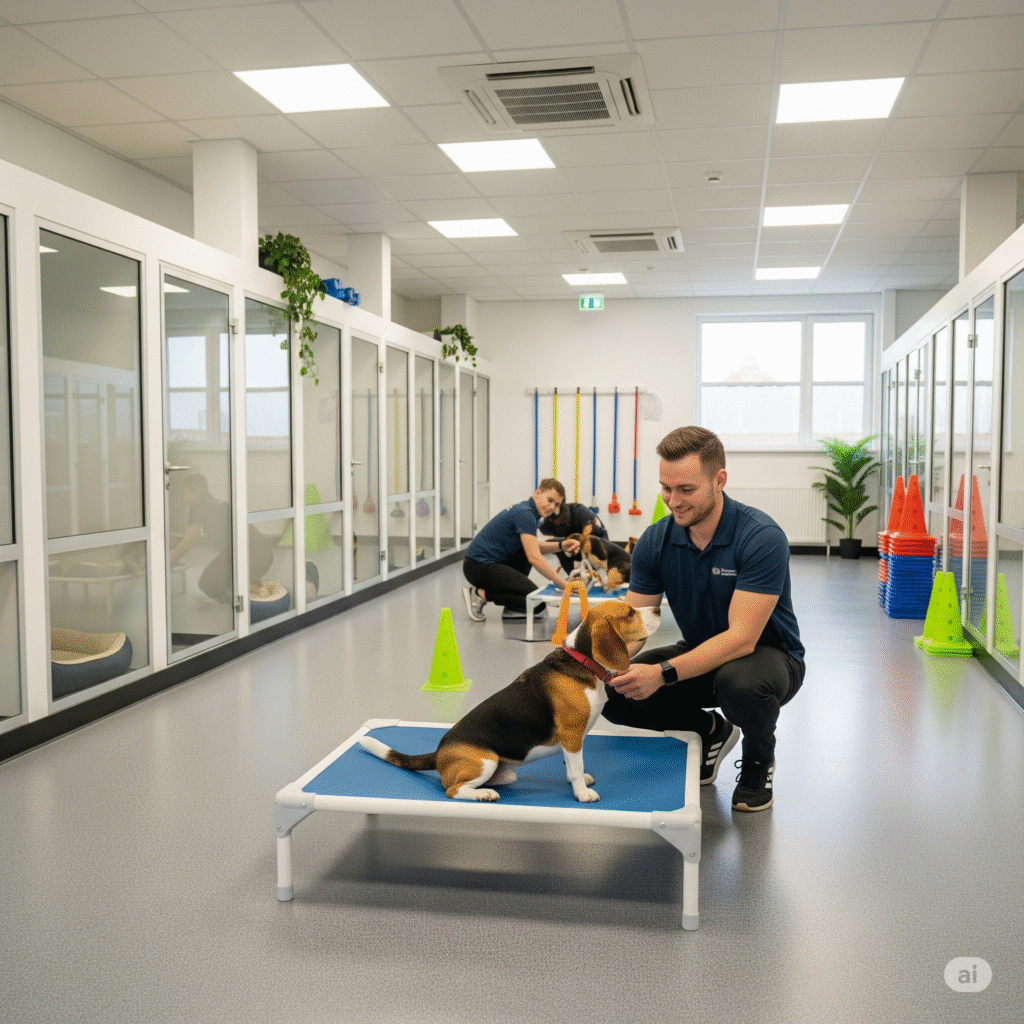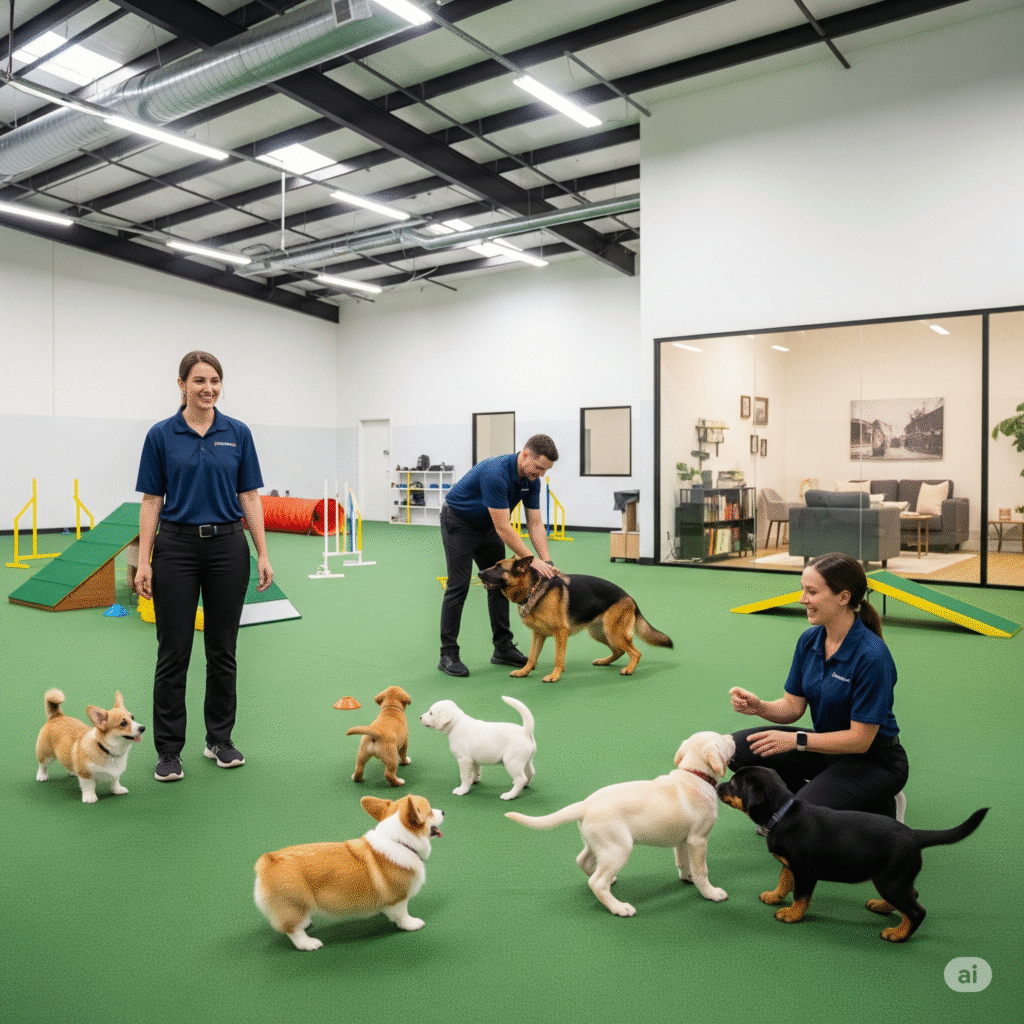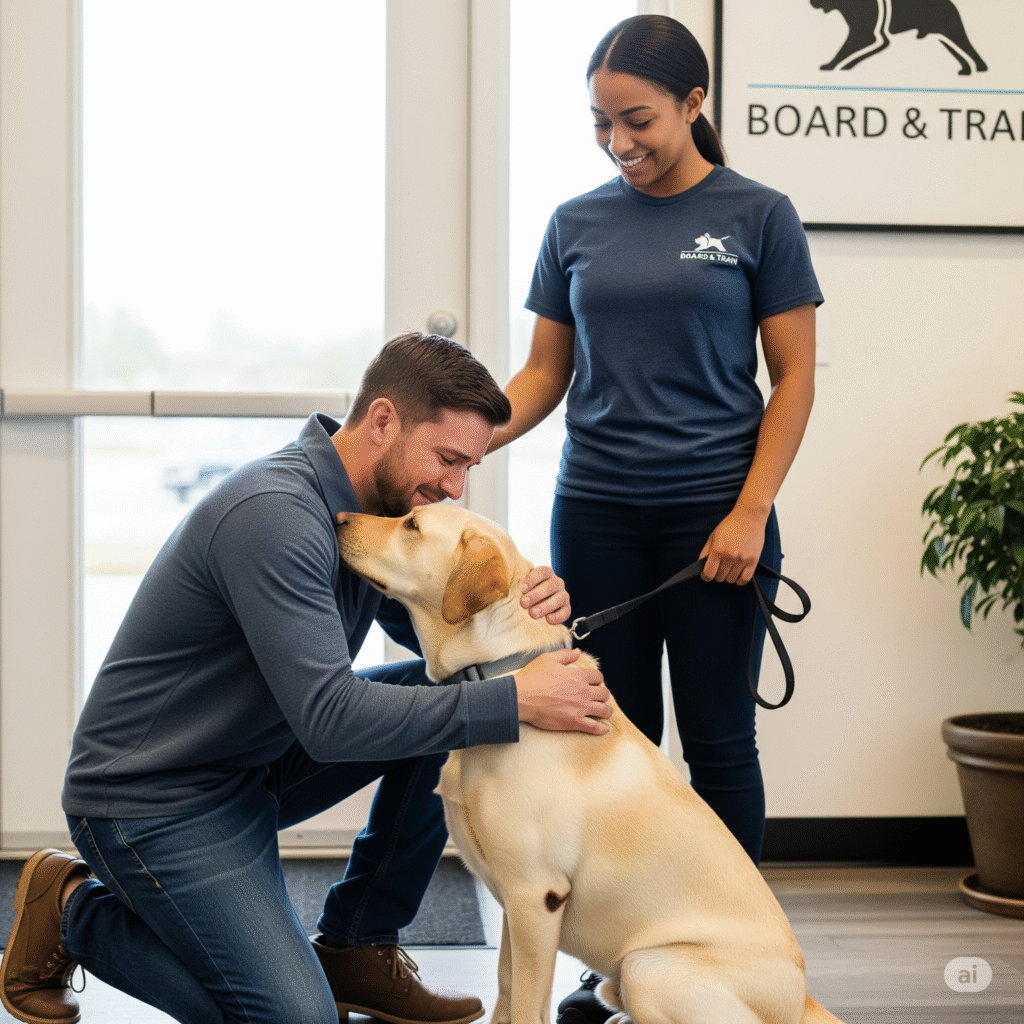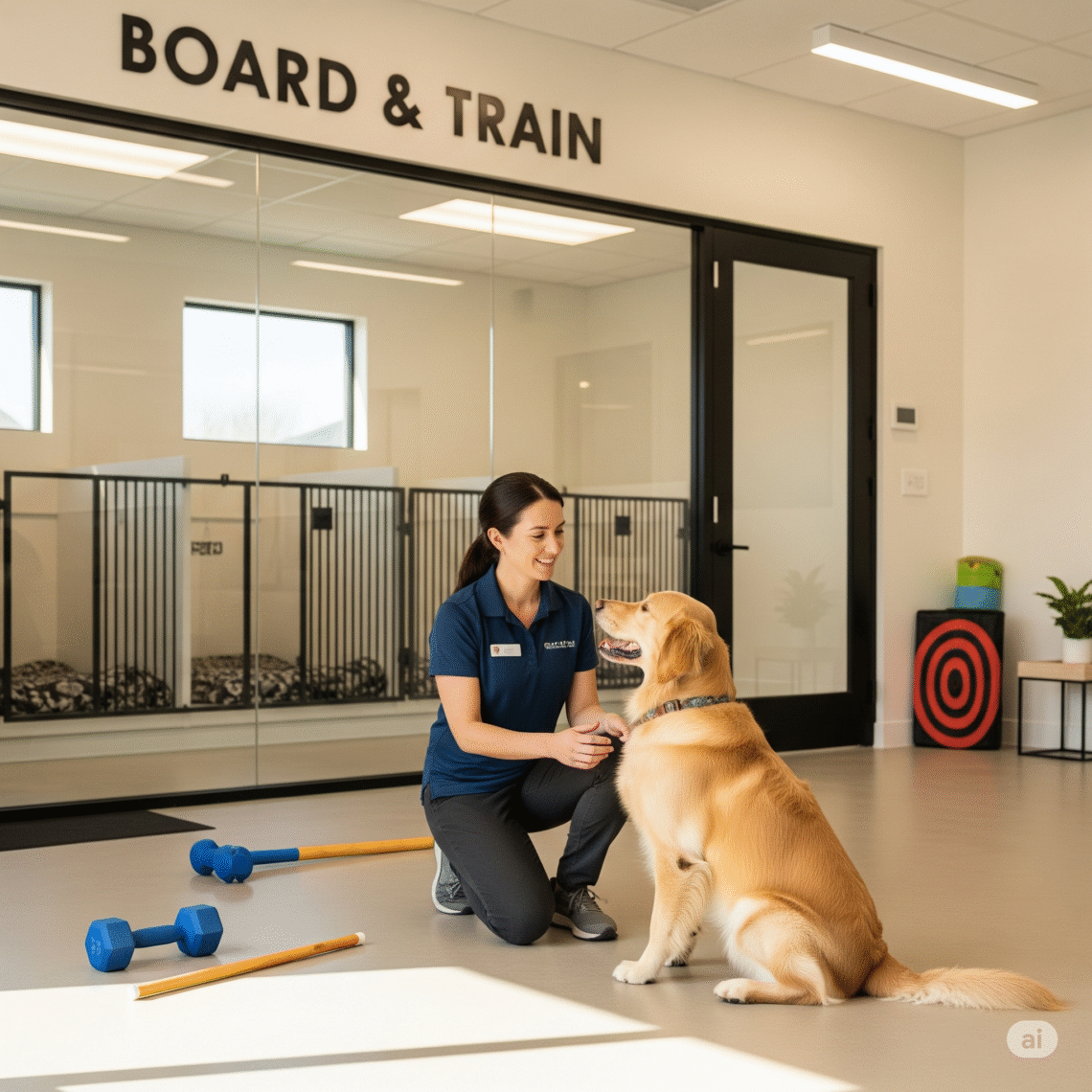Board and Train dog training is a popular and effective method for transforming your dog’s behavior through immersive, professional help. Instead of daily at-home lessons, your dog stays at a dog training facility where skilled trainers work with them every day.
This setup is ideal for busy owners or those facing serious dog behavior problems that need expert attention. From basic obedience training to complex issues like aggression or anxiety, this program offers tailored dog training solutions that create lasting change.
While it may seem intense, many pet parents find it’s the quickest path to a well-behaved pup. For the right dog, it can be life-changing—both for them and their owner.
What is a Board and Train Dog Training Program?
Board and Train dog training is a structured program where your dog lives at a dog training facility for a certain time. Trainers work with the dog daily, focusing on improving behavior, building commands, and reducing unwanted habits.
It’s a popular choice for pet owners who want quick and professional dog behavior solutions. This setup is especially helpful when the owner is too busy or lacks the knowledge to train their dog properly.

In a Board and Train dog training program, your pet stays in a professional setting, away from distractions. This setup helps trainers work deeply on specific issues like pulling on the leash, jumping, barking, or aggression.
Trainers use proven dog training techniques like positive reinforcement training to make sure lessons stick. The goal is to return a dog that listens better, behaves calmly, and adapts better at home.
Types of Board and Train Programs
There are many different programs depending on your dog’s needs. Some focus on puppy training programs, teaching young dogs basic commands and manners. Others target serious dog behavior issues, such as aggression, fear, or separation anxiety.
Some programs are short-term and focus on basic skills, while others are long-term and offer full canine behavior modification. You’ll also find dog training boot camps, which are more intense and may last several weeks.

These often include training dogs in a kennel with strict schedules. In contrast, some facilities offer in-home programs, where the dog stays with the trainer in a home setting.
These are great for generalizing dog behaviors to real-life situations. The right program depends on your goals and the dog’s temperament.
How Long Does a Board and Train Program Last?
Most Board and Train dog training programs last between two to six weeks. A short stay may teach basic commands like sit, stay, and come. Longer programs dive deeper into fixing dog behavior problems or providing aggressive dog training.
The more serious the behavior, the more time it takes to fix. The time also depends on your dog’s age, breed, and past training. Puppies often need shorter programs, while older or stubborn dogs need more time to adjust.

It’s important to ask about dog trainer qualifications, since the trainer’s skills impact how fast your dog learns. Don’t forget—continuing dog training at home after the program is key to long-term success.
How Much Does Board and Train Cost?
In the USA, dog training costs can vary. A basic two-week program may cost around $1,500. More advanced or specialized training can go up to $5,000 or more. Prices depend on how long your dog stays, what issues they have, and where the dog trainer services are located. Here is a general idea of the pricing:
| Program Type | Duration | Average Cost |
| Basic Obedience | 1-2 weeks | $1,200 – $1,800 |
| Behavior Modification | 3-4 weeks | $2,500 – $3,500 |
| Aggressive Dog Rehab | 4-6 weeks | $3,000 – $5,000 |
| Puppy Foundation Program | 1-2 weeks | $1,000 – $1,500 |
While it may seem expensive, many owners find the benefits of board and train worth the investment. You’re not just paying for lessons—you’re investing in safer, calmer, and positive dog behavior reinforcement.
Pros & Cons of Board and Train Programs
Board and Train has big upsides. Dogs get 24/7 professional care and coaching in a focused environment. That often leads to quicker results and better dog learning process. You don’t need to worry about doing everything yourself.
Trainers handle the hard parts using training techniques for dogs that work. Also, many dogs come back more confident, better behaved, and responsive to commands.
However, there are some board and train challenges. Your dog will be away from you, which can be stressful for both of you. There’s also the risk that your dog behaves well at the facility but struggles back home.

That’s why continuing dog training at home is so important. Without follow-up, even the best-trained dog can slip back into bad habits.
Benefits of a Board and Train Program
One major benefit is time. If you’re busy or not sure how to train, these programs offer a full dog training solution. Trainers work daily with your dog, using proven methods to build positive dog behavior reinforcement.
Dogs also learn in a routine, which improves how well they listen. Another benefit is skill. Dog trainer qualifications matter, and good trainers know how to fix problems fast.
They often use real-world setups to teach improving dog listening skills, leash walking, house manners, and more. Many owners notice changes within the first week.
Downsides of a Board and Train Program
One downside is the cost. High-quality programs are pricey. Also, since the owner isn’t involved in the day-to-day training, dogs might follow commands at the facility but ignore them at home.
This is a common dog training mistake—thinking training ends when the dog comes home. There’s also the issue of transparency. Not all facilities use kind methods. Some use harsh tools or punishment.
So always ask how they train, especially when training your dog effectively. Look for places that use positive reinforcement training, not fear-based methods.
Board and Train for Different Dogs
Some dogs adjust fast, others take time. Puppies can benefit from puppy training programs that focus on socialization and manners. Older dogs often need obedience training or help with behavior correction.
Rescue dogs may require canine behavior modification to feel safe and stable. Not every dog is a fit. Very shy or anxious dogs might struggle with being away.

But confident, social dogs often do great in a structured setting. Always consider your dog’s needs before signing up. A good trainer will also do dog behavior assessments before accepting your pet.
Board and Train for Aggressive Dog
Some programs focus on aggressive dog training. These are for dogs who growl, bite, or show reactive dog behavior. Trainers use a mix of desensitization, commands, and rewards. These programs take longer and may cost more.
Trainers work to reduce triggers and teach better reactions. They often include home-based dog training later on to ensure progress continues.
Still, results depend on the dog’s past, health, and consistency from the owner. Aggression is complex and takes time.
Reasons Why Board and Trains for Aggressive Dogs Aren’t Always Effective
While board and train can help, it isn’t a magic fix. Aggressive behavior often comes from fear or trauma. Removing a dog from its home doesn’t always solve the root cause.
That’s why some dog training alternatives, like in-home help or owner-led sessions, may work better. Also, owners must stay involved. If you don’t know how to manage triggers, the dog might relapse.

Many dogs act calm at the facility but return to old habits when home. So for serious aggression, long-term support and improving dog obedience at home are just as important as the program itself.
Frequently Asked Questions about Board and Train Dog Training
What are the board and train dog training prices?
Prices range from $1,200 to $5,000+ depending on duration, location, and training complexity.
Is board and train cruel?
No, if done with positive reinforcement; however, harsh or outdated methods can be harmful.
What are board and train dog training reviews?
Most reviews are positive when trainers are certified, transparent, and offer follow-up support.
What are board and train pros and cons?
Fast results and expert help are pros; cost and lack of owner involvement can be cons.
How board and train helps for aggressive dogs?
It can help manage aggression, but long-term success requires owner involvement after training.
Conclusion:
Board and Train dog training is a strong option if you want fast results and expert help. It works well for many pets, especially those needing obedience training or dog behavior solutions.
Still, success depends on the dog, the trainer, and what happens after the program ends. Before choosing a program, look for certified dog trainer services with great reviews. Ask questions, visit the facility and understand their dog training techniques.
Most importantly, be ready to keep working with your dog after they come home. That’s how you truly make the training last. Dog training boot camps might be intense, but with the right trainer, they can change your dog’s life and yours too.



